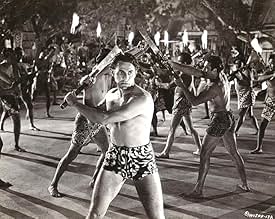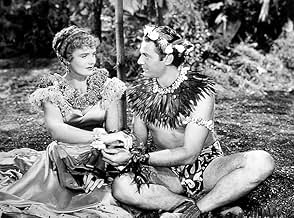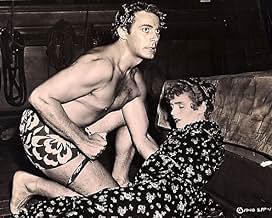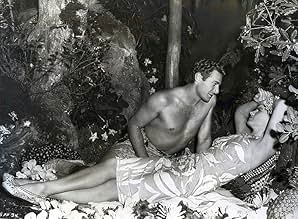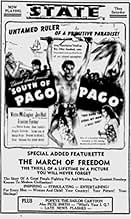IMDb RATING
6.3/10
169
YOUR RATING
The son of an island chieftain, young Kehane defiantly opposes the efforts by crooked pearl hunter Bucko Larson to invade his domain. Larson and his minions hope to dissuade the young man by... Read allThe son of an island chieftain, young Kehane defiantly opposes the efforts by crooked pearl hunter Bucko Larson to invade his domain. Larson and his minions hope to dissuade the young man by introducing him to seductive Ruby.The son of an island chieftain, young Kehane defiantly opposes the efforts by crooked pearl hunter Bucko Larson to invade his domain. Larson and his minions hope to dissuade the young man by introducing him to seductive Ruby.
- Awards
- 1 win total
Bobby Stone
- Hono
- (as Robert Stone)
Nina Campana
- Hono's Mother
- (as Nina Compana)
Julie Carter
- Native GIrl
- (uncredited)
- Director
- Writers
- All cast & crew
- Production, box office & more at IMDbPro
Featured reviews
This movie was an attempt to imitate the success of "The Hurricane" which was made three years earlier also starring Jon Hall as a Tarzan- like South Pacific Islander. Unfortunately, South of Pago Pago was NOT directed by John Ford and it showed.
The script is very predictable, the characters are one-dimensional and the acting varies from wooden to hammy. Whereas "The Hurricane" was able to develop a real insight into the soul of the islanders and their way of life, "South of Pago Pago" portrays them too simplistically to ever really identify with.
Please watch "The Hurricane" instead.
The script is very predictable, the characters are one-dimensional and the acting varies from wooden to hammy. Whereas "The Hurricane" was able to develop a real insight into the soul of the islanders and their way of life, "South of Pago Pago" portrays them too simplistically to ever really identify with.
Please watch "The Hurricane" instead.
When the film begins, an idiot sailor is way too talkative about some gigantic pearls he's found on a far off island. Now you'd THINK he'd keep this to himself...especially since he has found a captain and crew to take him back to where he got the pearls so that they can all become rich men. Instead, however, he's swayed by the blackhearted Captain Larson (Victor McLaglen) and his vicious femme fatale, Ruby (Frances Farmer). In fact, they are so evil that when they near the island with the pearls, they murder the poor sailor. Then, when they land, they behave like they love the locals and only want what's in their best interest. But when their pearl diving natives try to find pearls, all they find are tiny ones....making their trip a waste of time. But when they try diving in much deeper places, they hit pay dirt...gigantic pearls. But there is a major problem....it's so deep that the divers risk death and one does die from the bends. So, the local kahuna, Kehane (Jon Hall), orders the divers to stop. So, it's time for Ruby to use her sexy wiles and get Kehane to change his mind...and he does so because he's head over heels for this heel! What's next?
So is this any good? Well, it's pretty good...though it would have been nice if more parts had actually been played by Polynesian actors and if the sea battle late in the film hadn't been so cheesy. Jon Hall at least was in real life half-Tahitian....which makes this better than many similar films of the era. My assumption is that there just weren't that many Polynesian actors available on and around Catalina Island, California, where the film was made! As for the story, it's an interesting little parable about the evils of 'civilization' and its impact on innocents...and the impact this has on the scoundrels who invaded their paradise.
By the way, this film stars Frances Farmer, a woman whose life story, "Frances", is mostly fiction. She never was labotomized and much of the IMDB biography from her is based on a book that completely fabricated much of her life and experiences.
So is this any good? Well, it's pretty good...though it would have been nice if more parts had actually been played by Polynesian actors and if the sea battle late in the film hadn't been so cheesy. Jon Hall at least was in real life half-Tahitian....which makes this better than many similar films of the era. My assumption is that there just weren't that many Polynesian actors available on and around Catalina Island, California, where the film was made! As for the story, it's an interesting little parable about the evils of 'civilization' and its impact on innocents...and the impact this has on the scoundrels who invaded their paradise.
By the way, this film stars Frances Farmer, a woman whose life story, "Frances", is mostly fiction. She never was labotomized and much of the IMDB biography from her is based on a book that completely fabricated much of her life and experiences.
I can't express how fortiesishly luscious this is on every level. Any fan of that era who hasn't seen it 'ain't there yet.' Frances Farmer ! How could you describe her? [a curiously unblemished saloon girl in this one, but what the heck?] John Hall ! Victor McLaglen ! These people - who they were in the time in which they lived and worked - bigger & more beautiful than life - a part of that never-never fantasy world - that was so much illusion - once lived and so gone forever - of the forties.
SOUTH OF PAGO PAGO (United Artists, 1940), an Edward Small Presentation, directed by Alfred E. Green, is a South Seas adventure tale starring Victor McLaglen, Jon Hall and Frances Farmer in the leads. As much as this movie might have started a trend of other South Seas adventures that were common ground during the 1940s, with many produced in lavish Technicolor, this is not the first of this cycle. In 1937 alone, Jon Hall got his first big break in a leading role opposite sarong girl Dorothy Lamour in THE HURRICANE (Samuel Goldwyn) while Frances Farmer was featured in a Technicolor adventure of EBB TIDE (Paramount), based on the novel by Robert Louis Stevenson. Three years later, their paths would meet for this black and white adventure tale with enough island scenery that might have been more effective had it been produced in Technicolor.
Opening title: "This is a story of days not so long ago, when Singapore spawned a race of steel-fisted, iron-jawed adventurers, who lived happy, fought hard and died hard - as they ravaged unknown seas, lured by the priceless lusture of virgin pearls." Opening in Shanghai, China, at the Tingle Tangle Café, hostess Ruby Taylor (Frances Farmer) meets with Portuguese sailor, Manuel Forro (Abner Biberman) with news about rich pearl beds that can be found off the shores of Manoa. This news reaches Ruby's friends, Captain Bucko Larson (Victor McLaglen) and his first mate, Williams (Douglass Dumbrille), who invite both Ruby and Manuel aboard their steamer, the L.A. Dessa, bound for the island south of Pago Pago. Before reaching Manoa, Manuel, who's upset about being cheated of his promised share, is thrown overboard to the sharks by Bucko. Greeted by the natives, the crew is met by Kehase (Jon Hall), son of the island chief (Pedro De Cordoba). Although loved by Malia (Olympe Branda) since childhood, Kehase takes an immediate interest in Ruby, a beautiful white woman. Also on the island is Mr. Lindsay (Gene Lockhart), a white man who's been living among the natives for nine years, is not please by the presence by these visitors, which may mean trouble for his happy paradise. His instincts are correct. As the native boys dive for pearls, danger lurks for some, leading to certain deaths or injuries. Kehase insists the pearl diving must stop. Not wanting to leave the island with just twelve pearls to their name, Bucko uses Ruby to lure Kehase away, even to a point of marrying him and honeymooning on the island of Tua Tua. With Kehase temporarily out of the way, Bucko and his mates resume their greedy force amongst the native boys, risking their lives diving for more pearls and turning a once happy community into a fearful one. Also seen in the cast are: Francis Ford (Foster); Ben Weldon (Grimes); and Harry Woods (Black Mike Rafferty).
A South Seas tale that plays like a Saturday afternoon matinee is one that has done no harm in Jon Hall's movie career, considering a handful of similar adventures that would follow later on, especially those six over at Universal opposite the exotic Maria Montez. Hall does well as the island leader, but his accented manner of talking fails to come off convincingly. Aside from native drum playing and dancing, shipboard fights pearl diving dangers, the movie also contains off-screen chanting and singing to the title tune of "South of Pago Pago" by Chet Forrest, Bob Wright and Frank Loesser to round out the story. When Frances Farmer makes her first screen entrance in the cafe, her character, clothes and hairstyle strongly resemble that of her Lotta character from her breakthrough film, COME AND GET IT (1936). Once the story shifts towards the island of Manoa, she not only lets her hair down, figuratively, she appears slightly heavier in her physical appearance than before. Olympe Bradna, on loan from Paramount, makes a beautiful island girl. She even participates in a lively island dance with Jon Hall.
Not as well known as other films of this type, SOUTH OF PAGO PAGO did become available on VHS through VCI Home Video around 1998, and later onto DVD, assuring its rediscovery. Though cable television broadcasts are uncertain, it was once popular viewing on the late show or afternoon broadcasts during the 1960s and 1970s before taken out or circulation. Overlooking certain outdoor scenes that appear more indoor studio bound, with ordinary scripting, SOUTH OF PAGO PAGO moves swiftly during its 97 minutes of action and adventure. (*** pearls)
Opening title: "This is a story of days not so long ago, when Singapore spawned a race of steel-fisted, iron-jawed adventurers, who lived happy, fought hard and died hard - as they ravaged unknown seas, lured by the priceless lusture of virgin pearls." Opening in Shanghai, China, at the Tingle Tangle Café, hostess Ruby Taylor (Frances Farmer) meets with Portuguese sailor, Manuel Forro (Abner Biberman) with news about rich pearl beds that can be found off the shores of Manoa. This news reaches Ruby's friends, Captain Bucko Larson (Victor McLaglen) and his first mate, Williams (Douglass Dumbrille), who invite both Ruby and Manuel aboard their steamer, the L.A. Dessa, bound for the island south of Pago Pago. Before reaching Manoa, Manuel, who's upset about being cheated of his promised share, is thrown overboard to the sharks by Bucko. Greeted by the natives, the crew is met by Kehase (Jon Hall), son of the island chief (Pedro De Cordoba). Although loved by Malia (Olympe Branda) since childhood, Kehase takes an immediate interest in Ruby, a beautiful white woman. Also on the island is Mr. Lindsay (Gene Lockhart), a white man who's been living among the natives for nine years, is not please by the presence by these visitors, which may mean trouble for his happy paradise. His instincts are correct. As the native boys dive for pearls, danger lurks for some, leading to certain deaths or injuries. Kehase insists the pearl diving must stop. Not wanting to leave the island with just twelve pearls to their name, Bucko uses Ruby to lure Kehase away, even to a point of marrying him and honeymooning on the island of Tua Tua. With Kehase temporarily out of the way, Bucko and his mates resume their greedy force amongst the native boys, risking their lives diving for more pearls and turning a once happy community into a fearful one. Also seen in the cast are: Francis Ford (Foster); Ben Weldon (Grimes); and Harry Woods (Black Mike Rafferty).
A South Seas tale that plays like a Saturday afternoon matinee is one that has done no harm in Jon Hall's movie career, considering a handful of similar adventures that would follow later on, especially those six over at Universal opposite the exotic Maria Montez. Hall does well as the island leader, but his accented manner of talking fails to come off convincingly. Aside from native drum playing and dancing, shipboard fights pearl diving dangers, the movie also contains off-screen chanting and singing to the title tune of "South of Pago Pago" by Chet Forrest, Bob Wright and Frank Loesser to round out the story. When Frances Farmer makes her first screen entrance in the cafe, her character, clothes and hairstyle strongly resemble that of her Lotta character from her breakthrough film, COME AND GET IT (1936). Once the story shifts towards the island of Manoa, she not only lets her hair down, figuratively, she appears slightly heavier in her physical appearance than before. Olympe Bradna, on loan from Paramount, makes a beautiful island girl. She even participates in a lively island dance with Jon Hall.
Not as well known as other films of this type, SOUTH OF PAGO PAGO did become available on VHS through VCI Home Video around 1998, and later onto DVD, assuring its rediscovery. Though cable television broadcasts are uncertain, it was once popular viewing on the late show or afternoon broadcasts during the 1960s and 1970s before taken out or circulation. Overlooking certain outdoor scenes that appear more indoor studio bound, with ordinary scripting, SOUTH OF PAGO PAGO moves swiftly during its 97 minutes of action and adventure. (*** pearls)
It's a strange movie. Frances Farmer is the main attraction. This is not her ideal role- her patrician blond beauty seems a little out of place here. Although only 27 when she made the movie, she does not look quite as breathtaking as when she made Come and Get It 4 years earlier. Nevertheless, it is one of the few movies one can see Frances in. Jon Hall is an interesting character. I remember him from the 1950s as Ramar of the Jungle. Apparently he never sustained the successes in his early movies.
Did you know
- TriviaAlfred Green replaced Tay Garnett as director.
- GoofsEarly in the film, Frances Farmer's character asks for a Singapore Sling. There was no cocktail known by that name until the 1930s, around fifty years after the time this film is set.
- ConnectionsReferenced in La British Compagnie (2016)
Details
- Release date
- Country of origin
- Language
- Also known as
- Au sud de Pago Pago
- Filming locations
- Santa Catalina Island, Channel Islands, California, USA(underwater scenes)
- Production company
- See more company credits at IMDbPro
Box office
- Budget
- $800,000 (estimated)
- Runtime1 hour 38 minutes
- Color
- Aspect ratio
- 1.37 : 1
Contribute to this page
Suggest an edit or add missing content

Top Gap
By what name was Pago Pago, île enchantée (1940) officially released in India in English?
Answer

